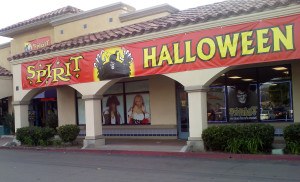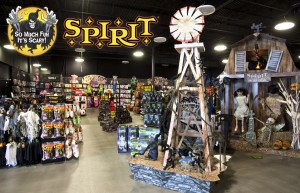PeekaBOO Pop-up Stores: Spirit Halloween

The scariest day of the year is actually the most fun, and most profitable, for Spirit Halloween. With its remarkable prowess among Halloween pop-ups, it has boasted the number one spot in Halloween retail, an $8 Billion industry, for the last several years.
 One day a year, everyone in the United States, and parts of Canada, pretend to be someone (or something) else for the day… it’s Halloween. Spirit Halloween started in 1983 and has been serving the holiday customer ever since, with all things Halloween and a primary focus on costumes. What makes it unique is that customers only ever see Sprit Halloweens stores… well… around Halloween.
One day a year, everyone in the United States, and parts of Canada, pretend to be someone (or something) else for the day… it’s Halloween. Spirit Halloween started in 1983 and has been serving the holiday customer ever since, with all things Halloween and a primary focus on costumes. What makes it unique is that customers only ever see Sprit Halloweens stores… well… around Halloween.
Pop-up Stores
Spirit Halloween has a very strict come-and-go model of doing business, meaning that its stores are only operational, and in fact only exist, in the weeks before Halloween. Termed “pop-up” stores, Spirit Halloween and many of its competitors build stores in vacant store-fronts two months before the holiday, and then deconstruct them within days after. The strategy is to capitalize on the extremely seasonal shopping habits of costume and accessory customers in the weeks leading up to Halloween, while avoiding unnecessary costs for the remainder of the year from having to sit idle, or stock different merchandise. All of this is in an effort to serve the merchandise demand for what is essentially a single day of the year, while somehow remaining a sustainable business. Spirit Halloween has designed their operating model to do just that.
The Spirit Halloween Experience

Frank Pecera, Senior Director of Real Estate at Spirit Halloween, says of the Company’s competitive advantage:
And the thing that sets us apart, too, from competition is our in-store experience. You just come into a Spirit Halloween store, and it’s not just about the costumes. It’s about the experience that we provide our customers within our stores. It’s like a show that we put on when you come into a Spirit Halloween store.
This is true, but Spirit Halloween does a lot of other things right. In order to open and close 1100+ stores across the 50 states and Canada every year, Frank and his team have to be on the prowl most of the year looking for locations for their stores. They target locations in the vicinity of other major retail stores to capitalize on the foot traffic. The typical yearly cycle is as follows:
- November-June: search for stores, secure contracts with landlords
- July-August: Hire employees, Train people. District managers to NJ for week-long training
- August 1: Take possession of store locations
- August-Labor Day: Build stores
- Labor Day –Nov 1: Sell merchandise
- November 1: Close stores
Incredibly, Spirit Halloween is able to hire and train 15000 employees in 4-8 weeks. Properties are claimed by early August, at which point store managers and their employees take over to build and stock the stores. Stores are up and running within 4-5 weeks, targeting to open to customers after Labor Day Weekend. Actual transactions with customers last about two months, generating ~$125M in sales, which accounts for half of the parent company’s (Spencer Gifts) annual revenue. Stores shut down abruptly the day after Halloween, and unsold merchandised is returned to warehouses to be repurposed for the next year.
This model comes with its own risks, most of which Spirit Halloween handles with exceptional processes: Finding profitable locations every year is hit or miss: Spirit Halloween is more often a hit by having a diligent analysis of past year area performance, targeting the best areas the next year, and setting up tent shops when store fronts are not available. Scaling up and down abruptly can be difficult without a big organization to absorb the demand spike: Spirit Halloween actually maintains a “skeleton crew” throughout the entire year. Though the company developed many of the standard operating processes, such as color coding displays and training videos, the stores are in fact run on a franchise model, where the franchisees operate on consignment and are responsible for rent and utilities.
A Winner’s Model
In all, Spirit Halloween has been able to capture value in what is perhaps one of the most distinct and ephemeral retail cycles that exists. Their strategy is to provide an enchanted experience to customers to stand out from their competitors, while only sticking around for the short time that Halloween shopping is relevant. Their operations have been designed beautifully to feed this strategy year after year, and has propelled them to the far-and-away leader in Halloween pop-up retail.
References
- https://www.spirithalloween.com
- http://www.forbes.com/sites/joshlinkner/2014/10/30/spirit-halloweens-scary-good-strategy/
- http://www.racked.com/2014/10/24/7571841/halloween-pop-ups
- https://docs.google.com/document/pub?id=12uJSkGujpYt1plZdvKaN7Zxa82SJWtCW9A5B1zGn2L8
- http://www.supplytimes.com/inventory-management/x-does-it-right-spirit-halloween-headquarters-pop-up-shops/?mode=featured



Thanks for the write-up. I always wondered why I only noticed Spirit stores right before Halloween. Makes sense to take stores down during the rest of the year since most people wont be buying Halloween costumes after October. Questions that popped up: For 2 month leases, is rent more expensive or less expensive since they’re occupying vacant property that wouldn’t be otherwise leased out? For unsold inventory, inventory management must be a mess. How is unsold inventory transported back and sorted, where are warehouses located, and how much are warehousing costs?
Hey Bobby,
Do you think Spirit Halloween has an opportunity to use this operational model to monetize Xmas, Easter, July 4th in a similar way? Is Halloween unique in some way that makes this model work more effectively?
Spirit is definitely an interesting model. Operations sounds fairly intensive year-round given the store only caters to one holiday. Are its margins fairly high after considering costs associated with year-round staff (to find store locations, plan, etc) as well as materials used to set-up stores, etc.? I also wonder how they are able to quickly hire and train enough quality temporary staff to support the pop-up stores…
Very interesting write-up, Bobby. While I had not heard of Spirit before reading your analysis, I’ve been in similar halloween pop-up stores in New York City run by a company called “Ricky’s.” I was wondering how far in advance Spirit needs to order its merchandise. While there are certainly “traditional” costumes that can be sold year in and year out, it must be difficult for the company to forecast demand for costumes closely tied to popular movies or current events. Additionally, due to the tight time frame, I imagine there is little flexibility to change product offerings during the season. It would be interesting to see what percentage of merchandise goes back into storage to be sold the following year and what percentage is scrapped.
Thanks for the write-up Bobby! I’ve never heard of a pop-up store before, and it was interesting to know how the stores operate throughout the year.
I wonder how Spirit’s business model and operation model will change in the future, considering that more and more people are buying halloween costumes on amazon. Do you think that they will try to compete with the e-commerce companies? or partner up with them?
This sounds super interesting, I am surprised that it is organized around only Halloween. I would imagine they need to be able to move a significant amount of volume at larger than average margins to support this business model in order to compete with the cost advantages of regular stores that would only need to changeover their seasonal merchandise. I am surprised at how they are able to sustain this success. I wonder how disruptive this is to the year-round party stores and why they do not expand scope to include the other holidays around the year.